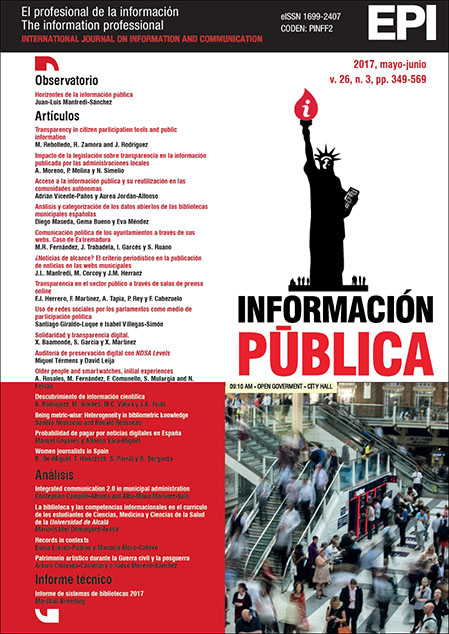Women journalists in Spain: An analysis of the sociodemographic features of the gender gap
DOI:
https://doi.org/10.3145/epi.2017.may.16Palabras clave:
Women, Female journalists, Spain, Gender gap, Sociodemographic features, Worlds of journalism study, Mujeres, Periodistas, España, Brecha de género, Características sociodemográficas, Worlds of journalism study.Resumen
Se analizan las características sociodemográficas y su peso relativo en la brecha de género entre los/as periodistas españoles/ as. Para ello se realizó una encuesta nacional representativa a 390 periodistas dentro del estudio internacional "Worlds of journalism study". Los resultados muestran que los patrones de desigualdad femenina más citados en la bibliografía científica (infrarrepresentación, barreras en la carrera profesional y salarios inferiores) prevalecen en las empresas de comunicación españolas. También confirman la hipótesis de las 3R (la ratio del Residuo Reforzado Recurrente): los hombres ocupan tres cuartas partes de los cargos de máxima responsabilidad gerencial y dos tercios de los puestos de toma de decisiones sobre contenidos, a pesar de que ellas poseen mayor formación académica y mayor nivel de estudios de capacitación en la práctica del periodismo. Ellas obtienen, además, salarios inferiores y tienden a ocupar cargos de mayor responsabilidad editorial en los medios digitales, donde se observan mayores avances hacia la igualdad.
Abstract
Sociodemographic features and their relative weight related to the gender gap between male and female journalists in Spain are analyzed. A national representative survey of 390 journalists was carried out as part of an international study "Worlds of journalism". The results show that patterns of female inequality within Spanish media companies are routinely cited in scientific literature (underrepresentation, barriers in their professional careers, and lower salaries than men). The results also confirm the 3R hypothesis (ratio of Recurrent and Reinforced Residuum): men hold three quarters of the posts with managerial responsibility and make two thirds of the decisions related to content, in spite of the fact that female journalists have higher levels of academic education and are therefore better trained for journalistic practice. Women are also paid lower salaries and tend to hold positions with a higher editorial responsibility in digital media, where the greatest progress towards equality is shown.
Descargas
Descargas
Publicado
Cómo citar
Número
Sección
Licencia
Condiciones de difusión de los artículos una vez son publicados
Los autores pueden publicitar libremente sus artículos en webs, redes sociales y repositorios
Deberán respetarse sin embargo, las siguientes condiciones:
- Solo deberá hacerse pública la versión editorial. Rogamos que no se publiquen preprints, postprints o pruebas de imprenta.
- Junto con esa copia ha de incluirse una mención específica de la publicación en la que ha aparecido el texto, añadiendo además un enlace clicable a la URL: http://revista.profesionaldelainformacion.com
La revista Profesional de la información ofrece los artículos en acceso abierto con una licencia Creative Commons BY.




